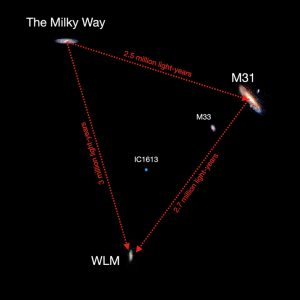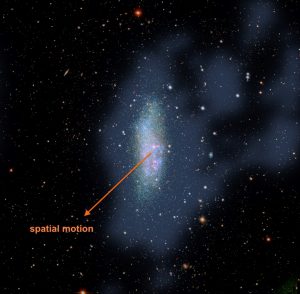A fully isolated dwarf galaxy unexpectedly affected by ram pressure
 Dwarf galaxies are known to be pristine probes of the early Universe, especially when they are isolated and not interacting with massive galaxies. Observations with the MeerKAT radio telescope of WLM, an archetype of such a galaxy, have revealed its strong interaction with the intergalactic medium.
Dwarf galaxies are known to be pristine probes of the early Universe, especially when they are isolated and not interacting with massive galaxies. Observations with the MeerKAT radio telescope of WLM, an archetype of such a galaxy, have revealed its strong interaction with the intergalactic medium.
An international team, including a researcher from the CRAQ and UCT, has discovered that the neutral hydrogen gas of the galaxy is getting removed by the ram pressure caused by the movement of the galaxy through the intergalactic medium, thought to be a tenuous layer of gas residing between galaxies. As mentioned by Professor Claude Carignan, from the Université de Montréal and member of the CRAQ: “It is the first time that an interaction with such a low-density medium has been discovered and this revolutionizes our understanding of dwarf galaxy evolution and formation.”
The team concluded that either these nearly “empty” inter-galactic regions are not really empty, or that the WLM galaxy is dark matter deficient.
Dwarf galaxies are affected by all the evolutionary processes normally at work in galaxies of any mass. As fainter and less massive galaxies, they are particularly susceptible to environmental mechanisms caused by a nearby giant galaxy such as gravitational tides or ram pressure stripping due to the surrounding gaseous medium. Such effects are considered to be the main sources of difference between “satellite” and “field” (or “isolated”) dwarf galaxy populations.
WLM was discovered in 1909 by Max Wolf, and then confirmed by Knut Lundmark and Philibert Melotte (hence the name WLM). It lies at more than 900 kpc (kiloparsec is a measurement of distance equal to 3 260 light years) from both the Milky Way and M31, and it is thought to be an archetype of an isolated dwarf galaxy formed in full isolation without any external perturbations. Thus, its dark matter mass is considered to be robustly determined, up to 90 times more massive than its baryonic matter, which is made of stars and gas.
WLM was recently observed by the newly constructed radio telescope MeerKAT, which is a precursor for the Square Kilometre Array (SKA) in Africa. From the very deep data, scientists identified four extended neutral hydrogen (HI) gas clouds in the northwest direction of WLM, in the opposite direction of its sky motion based on Gaia data.
Roger Ianjamasimanana from Rhodes University in South Africa explained: “The four clouds represent 10% of the total HI mass of the galaxy. We also found that there is a spatial offset between the WLM gas and stars.”
Including the four trailing HI Clouds, the research team concluded that the gas in WLM is subject to a strong wind from the surrounding gas medium that the galaxy is passing through, which is blowing the gas out of the galaxy.
 Lead author Yanbin Yang from Paris Observatory and CNRS France, clarified why this is so surprising: “The intergalactic medium in which WLM resides is assumed to be almost empty. Scientist have so far assumed that there was nothing that could have this effect on a galaxy.”
Lead author Yanbin Yang from Paris Observatory and CNRS France, clarified why this is so surprising: “The intergalactic medium in which WLM resides is assumed to be almost empty. Scientist have so far assumed that there was nothing that could have this effect on a galaxy.”
The team carried out computer simulations to study the effect in more detail. Yang shared: “Also in our simulations we found that the observations can only be explained if the intergalactic medium would be much denser than expected. We seem to have found a very large, unexpected reservoir of matter in the filamentary structure of the Universe.”
Alternatively, WLM’s mass could be much lower and perhaps without dark matter to explain how a very low-density medium is able to strip WLM’s gas via ram-pressure. But this would be revolutionary, since, as mentioned by Claude Carignan: “galaxies are thought to be dominated in mass by the mysterious unseen component.”
Independently of the exact answer, this study revolutionizes the understanding of dwarf galaxies. They cannot be no more considered as fully isolated in future studies.
Access the work ‘Evidence of ram pressure stripping of WLM, a dwarf galaxy far away from any large host galaxy published in the Astronomy & Astrophysics Letters. https://arxiv.org/pdf/2204.03662.pdf
Collaboration
Scientific team includes François Hammer (Observatoire de Paris – PSL, France), Yanbin Yang (Paris Observatory and CNRS, France), Roger Ianjamasimanana (Instituto de Astrofísica de Andalucía, Spain), Clare Higgs (Physics & Astronomy Department, University of Victoria, Canada), Brenda Namumba (Rhodes University, South Africa), Claude Carignan (Université de Montréal & University of Cape Town (UCT), South Africa), Gyula I. G. Józsa (Max-Planck-Institut für Radioastronomie, Rhodes University, South Africa), Alan W. McConnachie (NRC Herzberg Astronomy and Astrophysics, Canada)
Contact
Claude Carignan
claude.carignan@umontreal.ca
 Groupe d\’astrophysique de l\’Université de Montréal
Groupe d\’astrophysique de l\’Université de Montréal